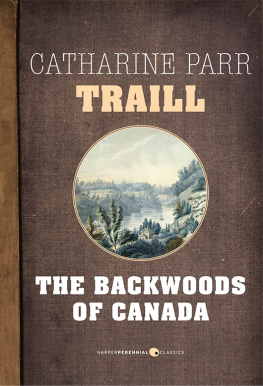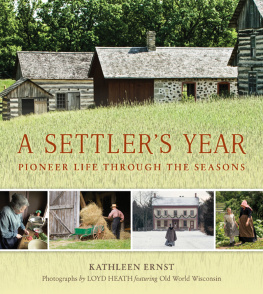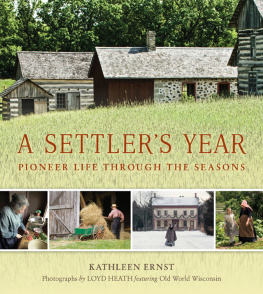Edwin C. Guillet - Pioneer Days in Upper Canada
Here you can read online Edwin C. Guillet - Pioneer Days in Upper Canada full text of the book (entire story) in english for free. Download pdf and epub, get meaning, cover and reviews about this ebook. year: 1963, publisher: University of Toronto Press, genre: Non-fiction. Description of the work, (preface) as well as reviews are available. Best literature library LitArk.com created for fans of good reading and offers a wide selection of genres:
Romance novel
Science fiction
Adventure
Detective
Science
History
Home and family
Prose
Art
Politics
Computer
Non-fiction
Religion
Business
Children
Humor
Choose a favorite category and find really read worthwhile books. Enjoy immersion in the world of imagination, feel the emotions of the characters or learn something new for yourself, make an fascinating discovery.

- Book:Pioneer Days in Upper Canada
- Author:
- Publisher:University of Toronto Press
- Genre:
- Year:1963
- Rating:3 / 5
- Favourites:Add to favourites
- Your mark:
- 60
- 1
- 2
- 3
- 4
- 5
Pioneer Days in Upper Canada: summary, description and annotation
We offer to read an annotation, description, summary or preface (depends on what the author of the book "Pioneer Days in Upper Canada" wrote himself). If you haven't found the necessary information about the book — write in the comments, we will try to find it.
Despite abundant hardships, pioneer life in Upper Canada was romantic and colourful, and Mr. Guillet brings vividly to life the early settlers and their experiences.
Pioneer Days in Upper Canada — read online for free the complete book (whole text) full work
Below is the text of the book, divided by pages. System saving the place of the last page read, allows you to conveniently read the book "Pioneer Days in Upper Canada" online for free, without having to search again every time where you left off. Put a bookmark, and you can go to the page where you finished reading at any time.
Font size:
Interval:
Bookmark:
PIONEER DAYS IN UPPER CANADA

By
EDWIN C. GUILLET

C OPYRIGHT , C ANADA , 1933
BY
E DWIN C. G UILLET
R EPRINTED 1963, 1966, 1968, 1970, 1973, 1975, 1979
BY U NIVERSITY OF T ORONTO P RESS
T ORONTO B UFFALO L ONDON
P RINTED IN THE U.S.A.
ISBN 0-8020-6031-5
LC 66-37656
This volume contains Section III of
Early Life in Upper Canada, Pioneer Life
The orders of architecture baffle all description: every one builds his cottage or house according to his fancy, and it is not a difficult thing, in passing through the country, to tell what nation the natives of the houses hail from, if we are aware of any of the whims and conceits that characterize them.
J OHN M AC T AGGART (1829).
T HE first homes in Ontario were those erected along the Detroit River by several hundred disbanded French soldiers, who were settled there in the last forty years of the French period. Their ctes, or long, straggling villages, resembled in appearance the settlements along the St. Lawrence in Quebec. The habitants cottages were low buildings with steep roofs, projecting eaves, and, as a general rule, dormer-windows. Sometimes they were built of logs, sometimes of rough stone if it were readily available, but in either case it was usual to cover the outer walls with pine boards which, when whitewashed, gave the cottages a neat and pleasing appearance. A windmill, or a cross, was quite frequently attached to the chimney of the house. An observer described the French-Canadians home as a little house with verandahs all round, few windows and few fancies; everything done with an air of humble comfort. Barns were built of rougher materials, usually logs, while root-houses and bake-ovens were constructed of rocks and clay. The home of the habitant had from one to three rooms on the ground floor, and the high-pitched roof provided a loft which was reached by a ladder and used as a sleeping-room. As in other pioneer homes, the floors were commonly made of timbers smoothed off with the axe, but the French often partly covered them with hand-woven rugs. Like those in Quebec, the Detroit River settlements were under the control of seigneurs, who lived in manor-houses varying but little, except in size, from the homes of the peasants.
The first English-speaking settlers in Upper Canada were almost entirely United Empire Loyalists, about 5000 in number. Most of the Loyalists came to Canada without worldly goods, their possessions having been either destroyed or confiscated by the revolutionists, or proving impossible to carry with them on their long and laborious trek to their new home in the wilderness. As they reached the government depots at Halifax and St. John in the Maritimes, Sorel, Chambly, Yamachiche, Cornwall and Kingston in the St. Lawrence region, and Niagara and Detroit in the west, they received their location tickets, supplies and rations, and proceeded to their lots at the first opportunity. A considerable number of German mercenaries who had fought for George III in the Revolutionary War came to Canada at the same time and under the same circumstances as the Loyalists.
Those approaching Canada from the east were conveyed by bateaux up the St. Lawrence, proceeding in brigades of twenty or more. The head of each family held a location ticket, describing the general position of his future land, and as the bateaux were laboriously worked up the rapids the occupants eagerly scanned the wild shores, comparing their appearance with the well-developed farms that they had left behind in order to remain British. Many of the Loyalists were soldiers, and almost every family had a military tent, capable of accommodating eight or ten persons in a very crowded manner. Each night the tent was pitched on the shore, and in the morning the monotonous voyage continued. When they had reached their location it was often necessary to remain encamped for some time, while the surveyors completed their division of the land into lots; and as the tents would not accommodate all, some had to sleep beneath the trees. In some instances the summer had passed before the first drawings of land were made; this delay greatly increased the hardship of the first winter in the woods.
At last the surveyor, with his map in front of him, checked off each lot as its number was drawn from a hat. The officers received their lots first, usually the best locations along the waterfront, while the private soldiers and civilians drew theirs from the back township locations. Occasionally lots were exchanged so that old comrades in the same regiment might be near-neighbours. The families, or sometimes the men only, then proceeded to their lot, carrying the tent, such tools and supplies as they had been issued, and a few days rations. It was often a difficult matter to identify the boundaries of their land, for the forests were full of matted undergrowth and fallen trees, and the undrained swamps and bridgeless streams presented still more formidable difficulties; but the tent was pitched and camp meals were cooked, while a suitable spot was chosen for the shanty after a general idea of the lay-out of the land had been obtained.
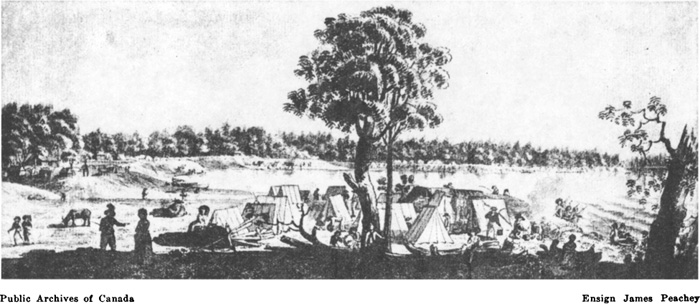
E NCAMPMENT OF L OYALISTS AT N EW J OHNSTOWN (C ORNWALL ), J UNE 6, 1784
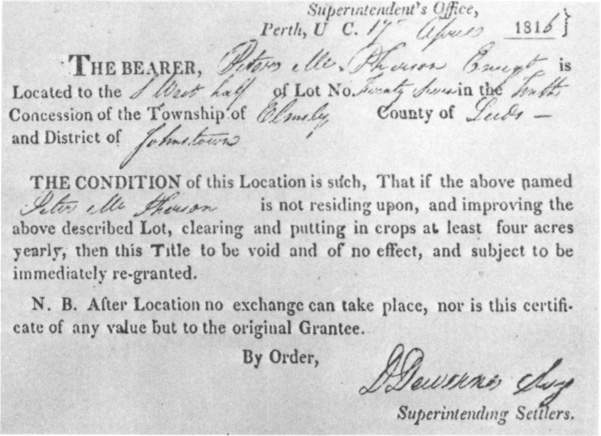
A L OCATION T ICKET , 1816
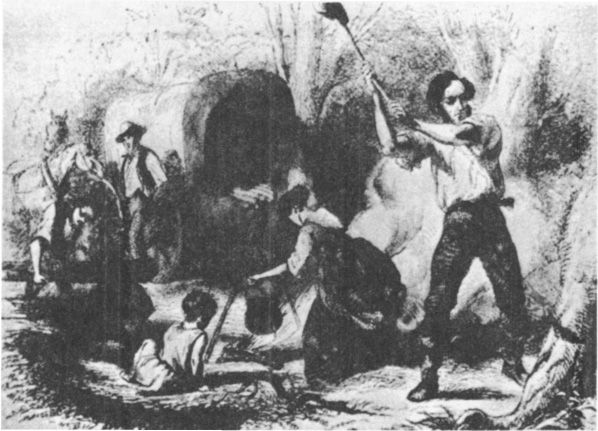
B EGINNING A H OME
Co-operation among settlers was a prominent feature from the first; neighbours helped one another in erecting their crude log shanties, the more difficult of construction because the short-handled ship-axes in general use were but little heavier than hatchets, and only a few other tools of use in the work were available. The log shanty was constructed in the same manner in the later pioneer periods as in Loyalist days; it might be as large as twenty by fifteen feet, but it was very often considerably smaller. The usual shanty was about ten feet long, eight feet wide and six feet high, with the roof sloping to the back, where the wall was frequently not more than four feet high. Round logs, often of basswood or pine, formed the walls. Under the base-logs large rocks were placed for support, and the logs were roughly notched at the corners so that they would fit into one another.
When the log walls had been run up to the desired height the rafters were set in position and the shanty roofed in. The slanting roof was sometimes composed of thick slabs of basswood overlapping one another; other settlers used strips of elm bark about four feet long and two feet wide, placed in overlapping layers and fastened by withes to the poles; while another variety of roof consisted of small hollowed basswood logs laid like tile. When the rude house had been completed, the appearance of its interior varied with the possessions of the owner, and his efforts to make it homelike. Thomas Needs shanty is an example of the success of a bachelor in making his home in the backwoods comfortable, even if crude.
Next pageFont size:
Interval:
Bookmark:
Similar books «Pioneer Days in Upper Canada»
Look at similar books to Pioneer Days in Upper Canada. We have selected literature similar in name and meaning in the hope of providing readers with more options to find new, interesting, not yet read works.
Discussion, reviews of the book Pioneer Days in Upper Canada and just readers' own opinions. Leave your comments, write what you think about the work, its meaning or the main characters. Specify what exactly you liked and what you didn't like, and why you think so.

